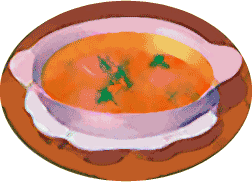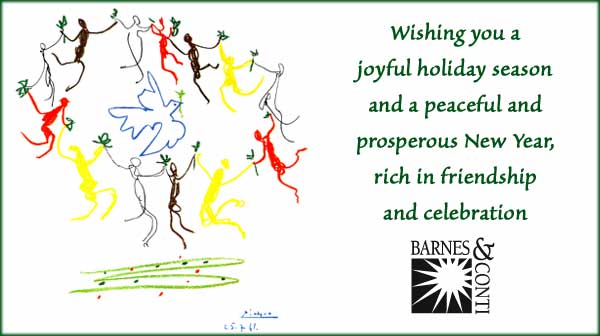A Yarn of Connection
One of the joys of the holiday season is the renewing of connections—whether through the exchange of greeting cards (actual or virtual), through gatherings of friends and neighbors, or through family celebrations. Over the past few months, I’ve had the good fortune of reconnecting with several valued friends and colleagues with whom I had, for reasons lost in the mists of time, lost touch. I have also experienced the delight of new connections and friendships with people from many different countries and of many different professions, ages, and points of view. (Perhaps the wide range is explained by my attendance at two events—my 50th high school reunion in St. Paul, Minnesota and a Halloween party for expats in Zurich where I was at least 30 years older than the next oldest person there!)
Reflecting on connections brought to mind a closing ceremony for a workshop I attended in the early ‘70s—Improvisational Theater Techniques for Teachers. A group of about 30 people stood in a large circle. Every fifth person or so was handed a ball of colored yarn; they were told to hold the end of the string and to toss the ball across the circle to someone they wanted to be connected to. Soon balls of yarn were flying through the air, caught, then thrown again, each person keeping the connecting string... Before long we had created a beautiful multicolored web of connections. When all the yarn had been used, we raised the web. It somehow got attached to the ceiling, and we danced under it for hours.
I later learned that yarn or string was sometimes used in this way a hundred or more years ago. Families would “toss the string” just before one of their members embarked on the excruciatingly long sea voyage to America. They knew that they might not see one another again. They wanted to remind each other of the connections in order to hearten and encourage one another, whether they were going or staying.
Keeping the connecting strands of love and friendship visible and creating new ones seems especially important in this world where we are at the same time both more connected and more isolated than ever before. In the spirit of the season, I wish you great joy and wonderful, warm, meaningful connections.
B.
Kim Barnes
President & CEO
In this Issue:
“Making the Best of Family Holidays,” by Eric Beckman
The Fifth Annual Barnes & Conti Virtual Feast
- Holiday Breakfast: Praline Muffin/Cookies (Meagan McCrystle)
- Appetizer: Caprese Skewers (Roslyn Raley)
- Soup: Carrot and Cashew Soup (Kim Barnes)
- Salad: Wilted Green Salad with Sun-Dried Tomatoes and Feta (Eric Beckman)
- Main Dish: Brisket of Beef (Joel Kleinbaum)
- Dessert: Orange Cheesecake (Kim Barnes & Don Bryant)
- For after the Holidays: Red Beans and Rice (all of us)
- Wine Recommendations
“Influential Casserole: A Tool for Dads Looking for Leverage,” by Carter Serrett
News Items:
Featured art (above): “La Ronde” by Pablo Picasso
Making the Best of Family Holidays
Eric Lewis Beckman, Vice President and CFO
It seems almost inevitable that traditional Christmas/Chanukah/Kwanzaa holiday get-togethers involve some family conflict. And yet, this is the time of year that most of us would like to be conflict-free. The message of the season is for peace, generosity, compassion, understanding, fellowship, and love. Unfortunately, our expectations and desires often end up at odds with reality. Wanting to make the holidays peaceful and idyllic may be desirable, but is not always achievable. Where do things go wrong, and what can we do to make family holidays better?
Many members of typical families (whether nuclear, divorced, or alternative) develop major discomfort around family celebrations and holidays. Both kids and adults can suffer mixed feelings of anxiety, confusion, frustration, anger, sadness, hurt, guilt, or even dread and depression. These feelings often affect other family members and friends, and can multiply by association. The result is that those ideal holiday feelings of family warmth, closeness, and cheer can end up fragmented at best, with some of us looking for an exit as soon as possible.
One of the major causes of interpersonal conflict hinges on expectations—either un-met positive expectations (I expect and/or hope for a wonderfully gracious and traditional holiday meal where love and respect abound), or negative expectations that are met (I expect uncle Bob will drink too much and make insulting or off-color remarks before the main course is even served). What happens when the first example doesn’t occur or the second example does? If these kinds of things have happened at your family gatherings in the past, were they ever resolved to your (or anyone else’s) satisfaction? Recent surveys have shown that almost 80 percent of respondents have unresolved family disputes.
“If you don’t like something, change it; if you can’t change it,
change the way you think about it.”
—Mary Engelbreit
Many of our own attitudes and expectations are developed at a very young age and stay with us our whole lives. Others are the result of personal experience and exposure to the dominant cultural messages of media and society. Social rules and family ideals are fueled by our primal familial desires for comfort, security, belonging, and love. We’re often unaware of how powerfully rules and ideals about family shape our holiday expectations and decisions. Fortunately, what we do with our attitudes and expectations can be a conscious choice.
There may be many reasons why others say things or act the way they do. However, we cannot control anyone’s actions but our own. If you want things to be different, be different yourself. If someone behaves in a disappointing manner, whether rude, disrespectful, or incredibly inappropriate, avoid an immediate reaction that might bring others into a dispute. At times a confrontation “in the moment” is not the best option, but look for an opportunity as soon as possible afterwards.
Focus first on how to get your own emotions in check. Look for ways to see the other person as worthy of some respect and decency. We have a tendency to want to “fix” the problem or the other person just when our emotions are most likely to undermine our effectiveness. If you approach someone believing they’re a jerk, an idiot, moron, etc., then you become the problem.
Try to find ways to make it safe for the other person to “hear” you in the first 30 seconds. Help them understand that you care about their interests and respect them. If you can’t think of something you respect about them, find someone else who can. When people sense that others don’t or won’t respect them, “hearing” disappears. Once the situation is “safe,” stick to just the facts. Most of us have a strong tendency when describing a problem to lace the description with judgment, labeling, accusation, and the inclusion of what I would call prior supporting evidence. The best thing to do is simply describe the behavior. If it was an offensive statement (for whatever reason), just quote it, neutrally ask the person what his or her concerns might be, and then listen. It is important, if not imperative, to create a dialogue and get the other person’s point of view.
Some ways to deal with your own and your part of the family’s attitudes and expectations is to clarify them in advance and define what they are. To help clarify your expectations, finish the following statements out-loud and without judgment or editing.
A family is...
A holiday is...
A celebration is...
Family traditions are...
At holidays and family gatherings, people ought to...
Are your statements the same as the rest of your family’s? How do you know? What agreements can you make with others before “the big event?” What might be some ways you and your family can contribute to success without judgment or criticism? Come up with some agreed-on code words or phrases that you can use to gently remind each other when slipping into judgment or accusation with others.
Finally, here are some “tips” to help you navigate the your way through holiday family events.
- Look for the positive in every situation, and remember that you choose your own attitude.
- Maintain some perspective, and try not to worry—“All things shall pass.”
- If a conflict arises, STOP–BREATHE–THINK before you open your mouth or act.
- Try doing it a little differently this time. You can only change yourself.
- Make sure to laugh, and don’t forget to cry. Both are essential to maintaining emotional balance in life.
Enjoy your time with family as much as you possibly can, and have a happy holiday.
Virtual Feast: Our Holiday Gift to You
This is our fifth annual holiday “virtual feast”! We started the tradition in 2001 because we couldn’t invite all of you to our annual holiday potluck. We now have so many recipes that we’re seriously thinking “cookbook” (watch our upcoming newsletters for details).
This year’s virtual feast focuses on connections. Many of the recipes here have been passed down from friends or family members. Other recipes are connected to important people in our lives in other ways. And one “recipe”—the soon to be infamous Turk-a-Choke Casserole—merited feature article status as an innovative use of influence and negotiation!
We sincerely hope that at least one of these recipes will brighten your holiday season.
For Your Holiday Breakfast: Praline Muffin/Cookies
Meagan McCrystle, Marketing Manager
 Meagan
got this recipe from her grandmother, Margaret McCrystle. Judging by this
recipe, Margaret must be one terrific baker! Look in our family notes for
a picture of Meagan with her grandparents.
Meagan
got this recipe from her grandmother, Margaret McCrystle. Judging by this
recipe, Margaret must be one terrific baker! Look in our family notes for
a picture of Meagan with her grandparents.
Ingredients:
- 1 cup brown sugar
- 1 cup chopped toasted pecans
- 1/2 cup flour
- 2/3 cup melted butter
- 2 beaten eggs
Method:
- Mix all ingredient together in small bowl.
- Spoon into mini muffin tins.
- Bake for 20 minutes at 350 degrees.
Caprese Skewers
Roslyn Raley, Desktop Publishing Manager
Here is another great appetizer recipe from Roslyn Raley, our Desktop Publishing Manager. Roz’s appetizers are a holiday tradition in their own right!
 Ingredients:
Ingredients:
- 1 pkg. 8-inch bamboo skewers
- 1 pint cherry or grape tomatoes
- 2 (1 lb.) tubs bocconcini (small balls of fresh mozzarella), drained
- 24 leaves fresh basil
- Extra-virgin olive oil for drizzling
- Balsamic vinegar for drizzling (optional)
- Salt and pepper
Method:
- Alternately skewer tomatoes and bocconcini bites, placing basil leaves between them.
- Drizzle the skewers with olive oil and balsamic vinegar; season with salt and pepper to taste.
Carrot and Cashew Soup
From the collection of Kim Barnes
Kim says this recipe has been in the family for 25 years or more; she doesn’t even remember where she got it. Kim says, “It was a big hit with my kids and is one of the few vegetarian recipes that’s really filling.” Kim’s “kids” are now fully grown, and Kim is enjoying her grandchildren.
 Ingredients:
Ingredients:
- 1 tbsp. butter
- 1/4 cup oil
- 1 1/2 cup chopped onion
- 4 cup grated carrots (tightly packed)
- 3 oz. tomato paste
- 1 cup chopped apple
- 6 cup stock (chicken or vegetable)
- 2 tsp. salt
- 1/3 cup brown rice
- 1 cup golden raisins
- 1 cup raw cashew pieces
- 2 1/2 cup yogurt
Method:
- Melt butter and oil in soup pot. Saute onion 1 minute, stir in carrots, and saute until onions are soft and transparent.
- Stir in tomato paste, apple, stock, and salt. Bring to boil and stir in rice.
- Cover and cook 45 minutes until carrots are tender, not mushy.
- Remove 1 cup of soup, whiz in blender until smooth, return to pot.
- Add raisins and cashews. Bring to boil and simmer about 5 minutes or until raisins are plump.
- Serve; add a dollop of yogurt to each bowl.
Serves 4-6
Excellent when reheated also.
Our Virtual Feast continues on page 2 (click here)
Please send feedback to newsltr1
at barnesconti.com
Barnes & Conti, 940 Dwight Way Suite 15, Berkeley, CA 94710, USA
Copyright © 2006 Barnes & Conti Associates, Inc. ALL RIGHTS
RESERVED.

